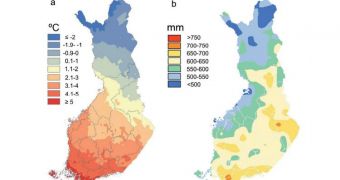Finnish Environment Institute (SYKE) PhD candidate Noora Veijalainen, M.Sc. (Tech.) has recently completed a series of computer models, detailing how the country will be affected by global warming and climate change throughout this century. The prospects revealed are not that bright.
According to other climate models, air temperature and precipitation patterns will change in Finland over the course of this century, affecting both water resources and the country's overall hydrologic cycle, says Veijalainen, a SYKE hydrologist.
In order to understand the impacts that the changing climate will have on discharges, water levels and floods in the country, the PhD candidate combined a series of climate scenarios with a large number of hydrological models, and then observed the outcomes.
The conclusions of her work could be used by authorities as background information in developing new approaches to handling the effects of global warming and climate change in Finland and elsewhere in the region. Lake regulation and flood risk management projects would benefit the most from this.
Veijalainen will present her discoveries on June 1, during a public examination and debate that will be held at the Aalto University, in Espoo, Finland. “The study shows that seasonal changes in discharges are the clearest effects of climate change,” she explains.
“Higher air temperatures caused by climate change affect snow accumulation and melt resulting in increased winter discharges and decreased spring snowmelt discharges,” she goes on to say.
One of the main conclusions of the study is that spring snowmelt would remain unchanged in volume until 2070 to 2090. At the same time, autumn and winter floods will increase in intensity, primarily in areas located around large lakes and the rivers that flow into them.
Veijalainen noted a great degree of variability in the results obtained from the model she compiled. Uncertainties built into the very models and methods she worked with are responsible for these variations.
It's important to note here that similar differences in results are obtained from most climate models, since it's impossible to include all natural variables and factors affecting the atmosphere, land and sea into a single computer model. The simulations therefore provide approximations of what may happen.

 14 DAY TRIAL //
14 DAY TRIAL //